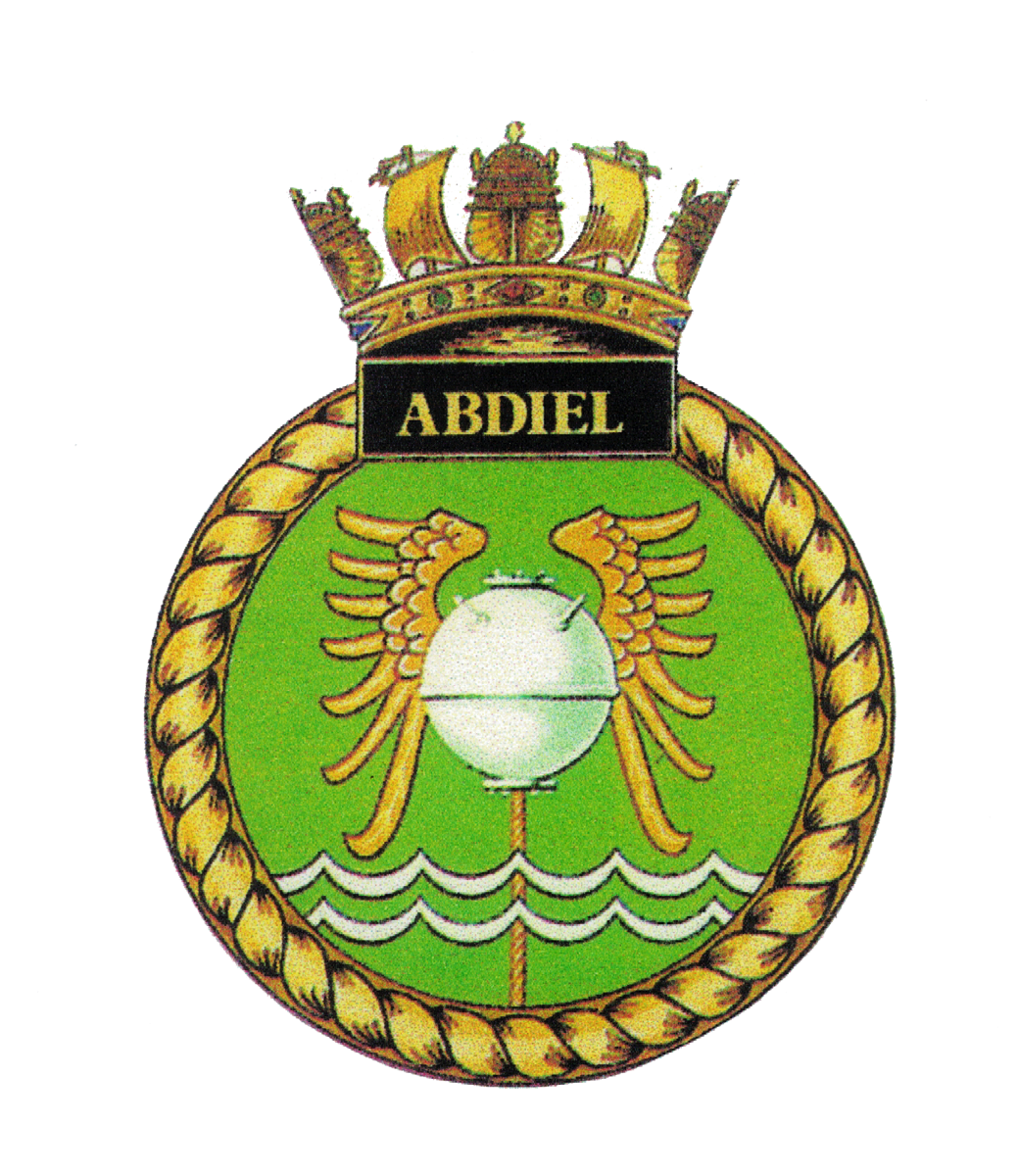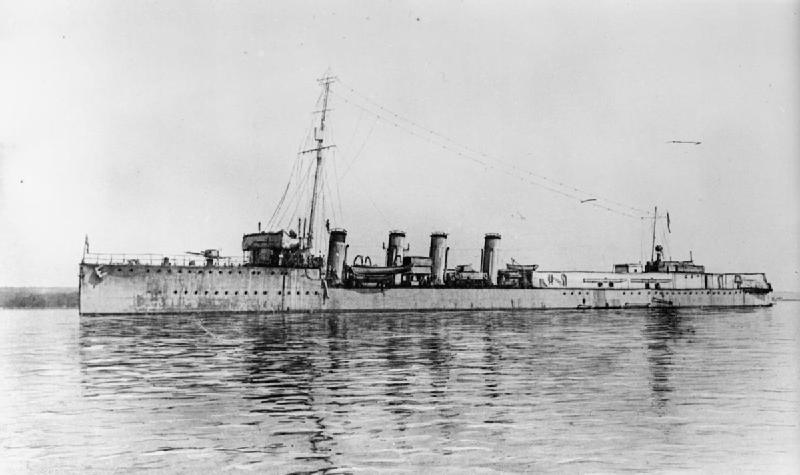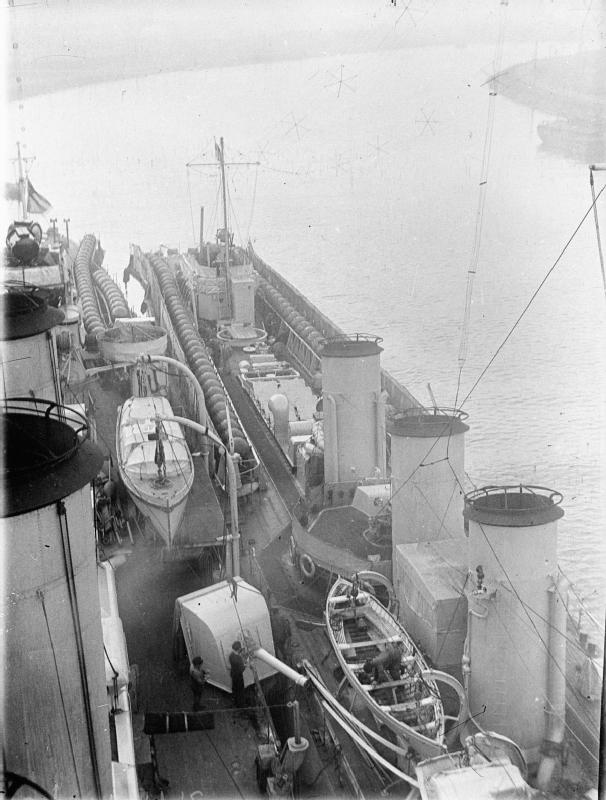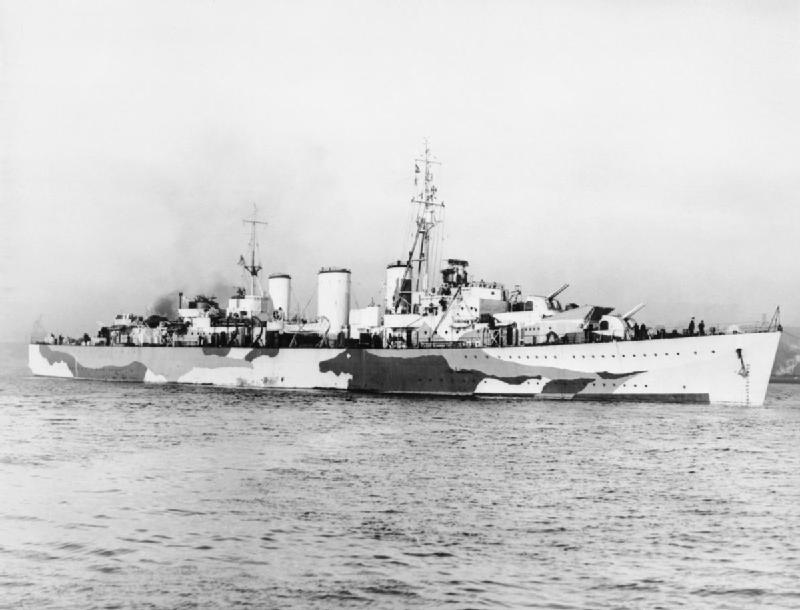John (Dusty) Miller's
HMS Abdeil
This name is taken from Milton's 'Paradise Lost'. Abdiel was the Archangel who remained faithful, and opposed Lucifer, when he fell from heaven and urged the angels to revolt'
Battle Honours
Jutland 1916
Biscay 1941
Libya 1941
Crete 1941
Sicily 1943

1915-1936
Destroyer, Marksman Class. 1,687 tons. Built by Cammell Laird, Birkenhead.
She was redesigned during the build to a minelayer to carry 70 mines. Launched 12th October 1915. Commissioned 23rd March 1916, Commander Berwick Curtis i/c, and joined the Grand Fleet. She saw service during the First World War of 1914-18. Her first mines were laid in the Heligoland Bight the very day after her commissioning, and from there on she dashed back and forth across the North Sea, each time depositing a fresh load of mines off the entrance to German harbours. She distinguished herself at the Battle of Jutland at the end of May 1916 when attached to the 4th LCS, by laying a field of mines in Homs Reef Channel through which the German Admiral Scheer' s High Seas Fleet was to pass. She did this in forty minutes, at 31 knots, laying 70 mines in an eight-mile stretch. Later that year Cmdr Curtis was promoted to Captain as leader of the 20th (minelaying) DF, Abdiel as the leader. The force was based at Immingham. She continued the rest of the war to harass the German High Seas Fleet by repeated mine laying dashes into German waters. The Abdiel laid 6,293 mines altogether. After the war in 1919 Abdiel mined the Gulf of Kronstadt and was also at Riga to help keep the peace. August 24th 1920 she reduced to Reserve at the Nore. September 14th 1925 she paid off into dockyard hands and given an extensive refit. 30th September 1926 commissioned at Sheerness for the Atlantic Fleet. But on January 25th 1927 she was again reduced to the Reserve at the Nore and remained as such until she was sold in July 1936 to Rees, Llanelly for breaking up.
1940-1943
Minelaying cruiser. Abdiel Class. 2,650 tons. 160 mines. Built by J.S.White, Cowes.
Launched April 23rd 1940. 1941- 7th March with a crew from Devonport various lays were carried out at Spithead as a preliminary to the first of class mine laying trials. On completion of these the ship proceeded to Greenock, arriving on the 20th March, where preparations were made for the carrying out of Builders trials. She was on trials in the Clyde when on the night of22/23rd March, orders were received to proceed to Milford Haven with utmost despatch. The passage was made at 35 knots and she arrived Milford Haven that afternoon. The panic being that the German battleships Scharnhorst and Gneisenau had arrived at Brest, a minefield hemming them in was vital, Abdiel was the only ship that could lay one. Mines were embarked at Milford Haven, and she arrived at Plymouth on the 23rd. Though still unofficially uncompleted and not officially commissioned she carried out two minelaying operations one well out to the west in the Atlantic and the second quite close to Brest, Operations GV GX and GY. After the operations various defects developed and since the ship had not been accepted from the builders she returned to Cowes for these defects to be made good. That these defects should have developed was hardly surprising. The ship had steamed 3,000 miles in ten days at a very high average speed. With the repairs effected and a fresh load of dummy mines embarked, Abdiel left Cowes again for Greenock on the 10th April. 36 hours after arriving at Greenock she left for Glasgow. On April 15th she was officially at last commissioned, Captain Hon E. Pleydell - Bouverie i/c. At Glasgow, large quantities of naval and military stores including 96 anti-tank guns were embarked, and during this period the ship was docked for examination of the special propellers which had been fitted, these were found to be so severely eroded that they had to be changed for a new set. On the 20th April she left in company with the Dido for Gibraltar where they arrived on the 24th then on to Malta and Alexandria, taking part in the convoy Operation Dunlop, on route.
Now part of the Mediterranean Fleet. May 2nd left Alexandria for Haifa to load mines returning on the 4th, the in company with other units of the Mediterranean fleet sailed as escort to a large convoy to Malta, Operation Tiger. 12th back in Alexandria. May 21st laid 150 mines east of Cape Dukato and within 24 hours the Italian destroyer Mirabello and the gunboat Matteucci, and the German transports Marburg and Kybfels were sunk in the field. 23rd May sailed from Alexandria with about 800 commando troops and 50 tons of stores and ammunition for Suda Bay. 24th troops and stores landed, and a certain number of evacuees embarked, including a higher proportion of the Greek Government.
A repeat trip was made to Crete from Alexandria on the 26th in company with the Hero and Nizam, this time carrying another 800 commando troops including Brigadier Laycock and about 50 ton of stores. On arrival at Suda Bay the troops and stores were unloaded and 500 wounded men embarked for the return trip. The three ships were bombed by dive bombers during the passage back. Alexandria was reached on the 27th. May 31st sailed with the Phoebe to start evacuating the island, the evacuation was continued until 0230 on the 1st June. In all somewhere around 5,000 to 6,000 men were rescued Abdiel accounting for about 1,200. Between 20th April and June 1st, Abdiel had been at sea for all or part of 36 days out of 42 and in that time steamed approximately 1,700 miles. In July one trip was made to Cyprus with loads of torpedoes for an MTB Depot ship and a cargo of sandbags. Towards the end of the month there commenced a series of operations for the reinforcement of Cyprus. In each of these troops and stores were embarked at Port Said and landed at Famagusta. These operations continued into August and towards the end of the month, the commencement of a series of similar ones were started to Tobruk these went on throughout September and October until the 16th November. In all Abdiel did 14 of these trips, and in this period conveyed somewhere around 6,000 men in and out of Tobruk and about 3,000 tons of stores. The last trip out of Tobruk was on the 15th November, General Sikorsky embarked with his staff, having been visiting Polish troops in the fortress. The first part of December was spent at Haifa, and on the 29th she took on a load of mines, and finally sailed on New Years night, for Port Said and the Far East. 1942- January 1st passed through the Suez Canal. Colombo was reached on the 10th January It was decided to carry out a series of mine laying operations with the object of blocking up the harbours of the Andaman Islands to prevent them being used by the Japanese. In the first of these operations, Port Blair, Elphinstone Harbour, Port Meadows and Kotara were dealt with. A second operation was carried out dealing with the harbours on the south and western sides of the Andamans, but immediately following the laying of the last mine in the entrance to Port Ansen, Abdiel struck a pinnacle of rock with her starboard screw. She returned to Trincomalee on her port screw and on to Colombo for docking. There it was decided to send her to Durban for repairs. March 10th sailed for Durban, via Addu Atoll and Kilindini with the damaged propeller stowed on deck. Repairs at Durban took a long while, she sailed on the 5th June for the UK, on route she picked up survivors from a merchant ship sunk by a Japanese raider.
9th June arrived Simonstown loaded stores, passengers and a large consignment of gold bullion, sailed on the 10th„ 14115th Port Noire. 17th Takoradi. 19th Freetown. 20122nd Bathurst. 25th Gibraltar. Arrived Greenock 29th„ July 1 st arrived on the Tyne. The ship was docked at Palmers Yard, Jarrow and it was there decided to fit a new shaft. It was also discovered that there was considerable distortion of a very large number of boiler tubes and, in consequence of the length of time required to complete the repairs the ship was partially reduced in compliment. December recommissioned Captain D,Orr-Ewing i/c. Laid a number of mines off the Ile de Vierge and the coast of Brittany. 1943- January repairs now completed, back in the Mediterranean. Based at Malta. 9th carried out mine laying operations against Italian convoy traffic between Gulf of Tunis and Sicily. Carried out three similar operations on the 3rd 7th and 27th February, and again 5th and 8th March and 5th 7th April. In July Abdiel was attached to Special Group X for the invasion of Sicily, Operation Husky. General Alexander was conveyed to the beachhead at Gela in the ship. In September the Allies occupied Taranto. Abdiel took some 400 paratroopers on board and joined the force led by the King George V. On the 9th the force entered Taranto and anchored. At 0030 on the 10th Abdiel, swinging at her cable, detonated a German-laid mine. There was a shattering explosion, the ship heaved almost out of the water, broke in half, and within seconds was gone. Survivors were picked up by other ships, but many of the crew were trapped below, and the paratroopers on deck were weighted down by their heavy equipment. 156 officers and men, naval and army, lost their lives.
1967-1988
Exercise Minelayer and MCM's Command Ship. 1,375 tons. Built by Thornycroft,
Southampton, at a cost of £1.Sm. Launched by Lady Hopkins on the 2i h January 1967.
Commissioned 17th October 1967, with a compliment of 98. 1968- Based in Scotland working with the Ist MCM' s Squadron as headquarters and support ship. May took part in Operation New Broom a multinational operation to clear the sea lanes of the NW coast of Europe. November visited Hamburg. 1969- Refitted. Took part in Exercise Grey Sextet off Texal. July visit to London. 1970- July took part in Exercise Love Song in the North Sea. In September took part in the large NATO Exercise Northern Wedding, followed by a visit to Trondheim. 1973- Home waters took part in Exercise Quicksave and a visit to Rendsburg. 1974- To the Mediterranean for Operation Rheostat, the clearance of the Suez Canal, from April to November, with short breaks in Malta and Cyprus. November 21st returned to the UK, via Gibraltar. 1976- With the Ist MCM' s Squadron took part in Exercise Squadex from Rosyth. Paid visits to Dan Helder, Flushing and Cherbourg. Later took part in Exercise Teamwork and Exercise Centex 76. 1977- Refitted. 1978- After major refit recommissioned at Malta. 1979- Rosyth with the 1st MCM's Squadron. Period in the Mediterranean and visits to Portugal and the Balearic Islands. September Leads 1st MCS for four weeks exercise with Spanish Navy. 1980- Rosyth. May took part in the NATO Exercise Open Gate off Portugal with the 10th MCM's Sqd. 1981- Part of Exercise Roast Beef off Tees and Humber. June/July from Rosyth for Scandinavia and the Baltic for one months exercises. 1982-Took part in the NATO Exercise Northern Wedding 82 in the Atlantic and Baltic. 1986- February 24128th visit to London. August/September took part in the NATO Exercise Northern Wedding 86. 1987- Based Rosyth. A busy year, by Spring had completed 4 months of trials in the Firth of Forth on the new British Aerospace Versatile Exercise Mine System, and managed to pull in Exercise Blue Harrier 87 in the North Sea and Exercise Norminex off France. September sent to the Persian Gulf, on the 14th arrived at Oman with four mine hunters, to start a five-month clearance of mines laid during the Iran/Iraq war. 1988- Persian Gulf. Suffered generator problems due to the heat and was relieved by the Herald in January. Returned to the UK in March and was paid off on May I 0th. In September she was sold for breaking up and left Portsmouth under tow for Spain and the breakers.


